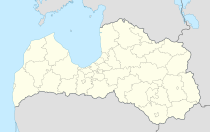Pāvilosta
| Pāvilosta ( German : Paulshafen) | ||
|---|---|---|
 |
|
|
| Basic data | ||
| State : |
|
|
| Landscape: | Courland ( Latvian : Kurzeme ) | |
| Administrative district : | Pāvilostas novads | |
| Coordinates : | 56 ° 53 ' N , 21 ° 11' E | |
| Residents : | 973 (Jul 1, 2018) | |
| Area : | 6.4 km² | |
| Population density : | 152 inhabitants per km² | |
| Height : | 5 m | |
| City law: | since 1991 | |
| Website: | www.pavilosta.lv | |
| Post Code: | ||
| ISO code: | ||
| Pāvilosta fishing and marina | ||
Pāvilosta (German Paulshafen ) is a small town in western Latvia between Liepāja and Ventspils , where the Saka flows into the Baltic Sea. In 2018 Pāvilosta had 973 inhabitants.
history
A place inhabited by cures at this point was first mentioned in writing in 1253. The place belonged to the Diocese of Courland and in 1795 became part of the Courland Governorate in the Russian Empire .
In 1879, Baron Otto von Lilienfeld initiated the construction of a harbor and named the place "Paulshafen" after his brother Paul , who was governor of Courland from 1868 to 1885. The port town developed slowly. It was only with the construction of the Libau war port in 1893 that the place revived through the shipping of building materials. In particular, the numerous boulders and other large stones found on the coast of Pāvilosta were used to build the quay walls in Liepaja.
A smaller shipyard produced 15 ships up to the First World War . The First World War badly affected the port. The only industry in the 1920s and 1930s was fishing. After the Second World War , a large fishing kolkhoz was formed, which was the main employer. In 1991 the place received city rights.
Sights, culture and sports
- Part of the original building from the 19th century has been preserved.
- A small local museum ( Pāvilostas novadpētniecības muzejs ) shows the history of the place and the fishing industry as well as the way of life of its inhabitants.
- There is a several kilometers long white sandy beach and north of the village in the direction of Jūrkalne there is a beautiful steep coast .
- In the summer there is a national sand castle competition.
- A marina has berths for around 30 sailing and motor boats, which have been awarded the Blue Flag (quality mark) .
- Pāvilosta is one of the most important surfing spots in the Baltic States.
- There are regular sailing regattas, surfing competitions, tennis and beach soccer tournaments. There is also a wakeboard facility with a lake swimming pool. In addition, tennis courts, a skate park and an ice hockey rink invite you to take part.
- There are sailing and surfing schools as well as a surfer café.
- Several music, art and open air festivals take place every year.
Economy and Infrastructure
fishing
Several small and medium-sized fishing companies operate in Pāvilosta. The largest of its kind employs around 66 people.
tourism
Tourism is an important economic factor in the region. Around 10,000 guests visit the Pāvilosta administrative district every year. In 2017 there were 45 guest accommodations and several campsites. Popular leisure activities include sailing, kite surfing, windsurfing, surfing, stand-up paddling, hiking, biking, spa visits, wakeboarding, canoeing and other water sports.
traffic
Pāvilosta is connected to Riga , Liepāja and Ventspils by bus lines . The P111 expressway connects Pāvilosta with Lithuania in the south and northern Latvia. The nearest airports are Liepāja (50 km), Palanga (115 km) and Riga (200 km).
education
In Pāvilosta there is a primary school, a secondary school and an art and music school. There are seven libraries in the county.
Pāvilostas novads
In 2009 the city formed an administrative community with 2 rural communities, which has 2801 inhabitants (as of July 1, 2018).
literature
- Astrīda Iltnere (ed.): Latvijas Pagasti, Enciklopēdija. Preses Nams, Riga 2002, ISBN 9984-00-436-8 .
Web links
- Pictures from Paulshafen / Pāvilosta
- Images from the Pāvilosta County
- Official tourism brochure of the city council
Individual evidence
- ↑ a b Latvijas iedzīvotāju skaits pašvaldībās pagastu dalījumā (= population figures of the self-governing districts of Latvia)
- ↑ Sigurds Rusmanis, Ivars Vīks: Kurzeme . Izdevniecība Latvijas Enciklopēdija, Rīga, ISBN 5-89960-030-6 , p. 12.
- ^ Website of the museum (Latvian), accessed on May 11, 2017.
- ↑ Pāvilostas osta - Pāvilostas novads. Accessed December 31, 2018 .
- ↑ Pāvilostas NOVADA. Accessed December 31, 2018 .
- ↑ Pāvilostas novada Tūrisma informācijas centra. (PDF) Accessed December 31, 2018 .
- ↑ tourism brochure administrative Pāvilostas. (PDF) Retrieved December 31, 2018 .
- ^ Pāvilostas vidusskola - Pāvilostas novads. Accessed December 31, 2018 .




